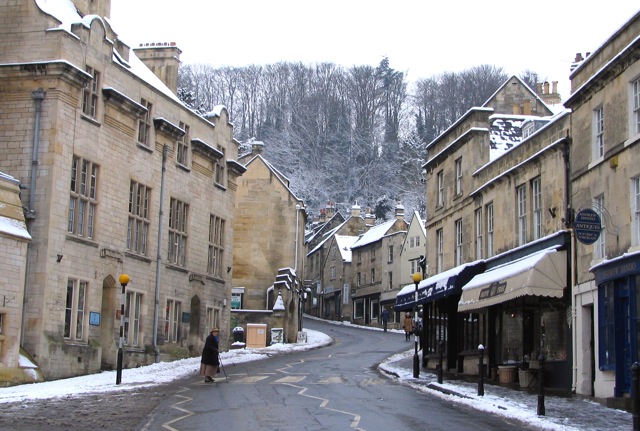.
Explore Bradford on Avon: Market Street
Bradford on Avon, Wiltshire
.
.
Market Street runs from the bridge and up the hill northwards, in the direction of Bath. It was only named as such in the mid-19th century, when the market moved from Silver Street. The lowest bit was called Horse Street (from an old word meaning muddy, not from a horse) and the rest was called Pippet Street (derivation not known). Like most streets in Bradford, the numbers run up the left side, then back down the other.
> Old photographs of Market Street
Click on the thumbnail photographs for a bigger view.
.S
East side
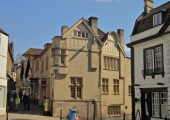 At the junction of The Shambles and Market Street was the Post Office. It was built in two stages: in 1901 (opening in 1904) and in 1936, but Royal Mail has now closed it. Next it is the golden postbox that was repainted to celebrate the winning of a gold medal by Bradford’s Ed McKeever in the 2012 London Olympic Games.
At the junction of The Shambles and Market Street was the Post Office. It was built in two stages: in 1901 (opening in 1904) and in 1936, but Royal Mail has now closed it. Next it is the golden postbox that was repainted to celebrate the winning of a gold medal by Bradford’s Ed McKeever in the 2012 London Olympic Games.
.
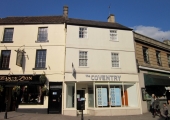 The Coventry (formerly Stroud & Swindon) Building Society, number 36, opposite the Post Office, was C. & M. Boorman draper-outfitter c1900, from 1904 Soul draper and milliner, then Miss J.A. Francis in the 1950s and 1960s. Photographs from the early 20th century show that the windows of the first floor were canted forward and continued down to the shop front below.
The Coventry (formerly Stroud & Swindon) Building Society, number 36, opposite the Post Office, was C. & M. Boorman draper-outfitter c1900, from 1904 Soul draper and milliner, then Miss J.A. Francis in the 1950s and 1960s. Photographs from the early 20th century show that the windows of the first floor were canted forward and continued down to the shop front below.
.
 The Dandy Lion public house, number 35, was the grocer shop of the Smart family in the late 18th and early 19th centuries; Thomas Smart’s painted name board is still underneath the present one. Another grocer, Albert Nichols, succeeded him late in the century and, as Nichols & Bushell, the grocery continued until the 1960s. It was converted into a restaurant called the Shandon Steak-house in the 1970s, becoming a bistro/pub called the Ancient Fowl (probably a dig at the Swan Hotel across the road) and finally under its present name.
The Dandy Lion public house, number 35, was the grocer shop of the Smart family in the late 18th and early 19th centuries; Thomas Smart’s painted name board is still underneath the present one. Another grocer, Albert Nichols, succeeded him late in the century and, as Nichols & Bushell, the grocery continued until the 1960s. It was converted into a restaurant called the Shandon Steak-house in the 1970s, becoming a bistro/pub called the Ancient Fowl (probably a dig at the Swan Hotel across the road) and finally under its present name.
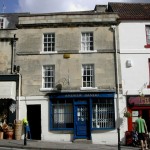 Number 34 Market Street, has a double bow-fronted window. The Misses Anna Bedford and Mary Horton ran their confectionery and fancy goods shop here in the 1880s to 1900s. The office of auctioneer Snailum was there in the 1950s and 1960s and it was the shop of West County Cleaners in the 1980s and 1990s. Recently it was Andrew Dando Antiques and now an office.
Number 34 Market Street, has a double bow-fronted window. The Misses Anna Bedford and Mary Horton ran their confectionery and fancy goods shop here in the 1880s to 1900s. The office of auctioneer Snailum was there in the 1950s and 1960s and it was the shop of West County Cleaners in the 1980s and 1990s. Recently it was Andrew Dando Antiques and now an office.
The doorway to the left leads to an alleyway with other buildings at the rear, where was F.H. Blair & Son’s coal merchant office in 1958, 1961.
.
Number 33. This was an ironmongery in the 19th century, run by a succession of people, including plumber William Bigwood in 1899, then Henry Beard ironmonger in 1911 who called it “Ye Padlocke”. Uncles & Son’s shoe shop moved here from the corner of Silver Street and Market Street in 1934 and remained there until it closed in 1987; some items from Uncles’ shop are in Bradford Museum. The Olive Tree gift shop closed in 2014 and has been occupied by dress agencies, currently The Roundabout Shop, previously in Silver Street.
Number 32, was Southwell’s boot and shoe shop in 1887, W.E. Williams Ltd, drapers in 1965. It was Avon Antiques until the beginning of 2009, when Andrew Jenkins retired and became Artemis Gallery. The Georgian façade appears to have been rebuilt on the front of an older building that had a gable end to the street, rather like the flat front of a wild west saloon.
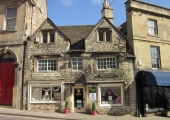 Number 31. This is a mid to late 17th century building with two gables and low ceilings. The mullioned windows of the first floor were replaced by horizontally-sliding sashes, possibly among the last surviving in Bradford. It was originally a house into which the two shop windows have been inserted later. As a shop, it has been several things, including a succession of gift or fancy goods shops and was called Grey Tiles. It was Dible & Roy’s drapery shop in the 1980s, before they moved to bigger premises in Bridge Street. Since then it became the original Dorothy House charity shop, which is now in the Shambles.
Number 31. This is a mid to late 17th century building with two gables and low ceilings. The mullioned windows of the first floor were replaced by horizontally-sliding sashes, possibly among the last surviving in Bradford. It was originally a house into which the two shop windows have been inserted later. As a shop, it has been several things, including a succession of gift or fancy goods shops and was called Grey Tiles. It was Dible & Roy’s drapery shop in the 1980s, before they moved to bigger premises in Bridge Street. Since then it became the original Dorothy House charity shop, which is now in the Shambles.
.
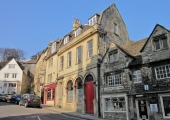 The Town Club, number 29. There was a public house here called the Maiden Head Inn in 1611. The present building dates from 1755 and Richard Pearce, landlord of the Cross Keys in Frome Road. He was a friend of John Wesley, the founder of the Methodists and at the back there is a chapel where John and Charles Wesley often stayed and preached. A new chapel was built in Coppice Hill in 1818 and this building became a draper and a printing works. From 1903 to 1921 it was the Conservative Club and has served as the non-political Town Club since then. From October 2017 part of the building has again become a public house- The Stumble Inn.
The Town Club, number 29. There was a public house here called the Maiden Head Inn in 1611. The present building dates from 1755 and Richard Pearce, landlord of the Cross Keys in Frome Road. He was a friend of John Wesley, the founder of the Methodists and at the back there is a chapel where John and Charles Wesley often stayed and preached. A new chapel was built in Coppice Hill in 1818 and this building became a draper and a printing works. From 1903 to 1921 it was the Conservative Club and has served as the non-political Town Club since then. From October 2017 part of the building has again become a public house- The Stumble Inn.
Hair at 28 is a two-bay building of three storeys and attic. It has the distinction of having been Bradford’s first post office, functioning as such until the new office was opened in the Shambles in 1901. During the the 20th century it was a fish shop then confectionery and tobacconist’s shop.
25 to 27 were built as a line of three houses, but are now one and housed an antiques business for 46 years until 2009. They have large double windows on the top storey, which usually in this area suggests that this floor may have been used for cloth weaving.
Number 24, along the narrowing alley, is a 17th century or earlier house with two gables. Sash windows were inserted in the next century and an 18th century date is scratched on one of the panes.
The White House sits back from the road and has an old shop window facing that way; the rest is late 17th century, with a early 18th century hooded porch on the uphill side. The grilled arch underneath covers the ancient Pippet Well, which supplied water to this part of the town until the coming of mains water in 1883.
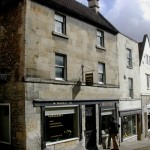 Peaches hairdresser, number 19, is another late 17th century building with its gable end to the street, although the windows on that end have been replaced and a shop front inserted.
Peaches hairdresser, number 19, is another late 17th century building with its gable end to the street, although the windows on that end have been replaced and a shop front inserted.
Numbers 17 and 18 (left)were the premises of Edward Rooth picture framer until he retired.
Number 16, with gable end towards the road was a blacksmith’s forge operated by the Summers family from at least 1830 until 1922. It was Stan Green’s cycle and toy shop in the second half of the 20th century. Carter & Harding opticians took over the shop after he retired, but moved to part of the old Post Office in the Shambles in 2016.
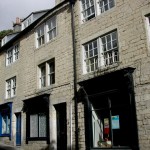 Number 15, formerly Piha ski ‘n’ surf shop (now moved to Lamb Yard), was for much of the 20th century an electrician’s shop, first of W.H. Rossiter and later of F.H. Way. It has a 19th century front, but there are 17th century windows at the rear. The doorway leads to a back garden where there was a substantial old bakery building.
Number 15, formerly Piha ski ‘n’ surf shop (now moved to Lamb Yard), was for much of the 20th century an electrician’s shop, first of W.H. Rossiter and later of F.H. Way. It has a 19th century front, but there are 17th century windows at the rear. The doorway leads to a back garden where there was a substantial old bakery building.
Numbers 9 to 14 (left) have mostly been residential, although they have Victorian shop windows. Number 9 was demolished to allow better traffic movement, which now of course is too much better. 10 and 11 were restored from semi-derelict condition by Bradford’s Preservation Trust. In the 1980s 14 was Bertie Golightly, a dress agency that was so successful it moved to Brompton Road in London.
Market Street: west side
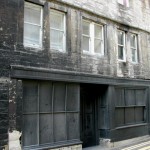 Horse Street is the short narrow part at the bottom of Market Street. Number 2 is a building that dates from the end of the 17th century, but has had a big shop front inserted on the ground floor when it was possible for people to look at it. It was Carter’s butcher’s shop in the late 19th century, but is now part of the rear of the Swan Hotel.
Horse Street is the short narrow part at the bottom of Market Street. Number 2 is a building that dates from the end of the 17th century, but has had a big shop front inserted on the ground floor when it was possible for people to look at it. It was Carter’s butcher’s shop in the late 19th century, but is now part of the rear of the Swan Hotel.
On the opposite side the estate agent is what remains of the White Hart Inn, which became a temperance hotel and tea shop and then Knee’s hardware store.
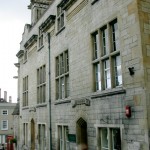 Bradford’s old Town Hall occupies the corner of Church and Market Streets. It was built in 1855 by a private company and leased to the council and held offices, council chamber which was also used for the Magistrates’ court and the police station. It was designed by Thomas Fuller (1823-98) of Bath, who went on to design the Parliament in Ottawa, Canada and the New York State Capitol. In 1911 the new Urban District Council found smaller premises at Westbury House. Eventually the building became St Thomas More Roman Catholic Church and the Midland (later HSBC) Bank.
Bradford’s old Town Hall occupies the corner of Church and Market Streets. It was built in 1855 by a private company and leased to the council and held offices, council chamber which was also used for the Magistrates’ court and the police station. It was designed by Thomas Fuller (1823-98) of Bath, who went on to design the Parliament in Ottawa, Canada and the New York State Capitol. In 1911 the new Urban District Council found smaller premises at Westbury House. Eventually the building became St Thomas More Roman Catholic Church and the Midland (later HSBC) Bank.
.
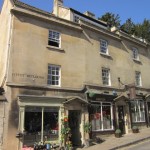 Pippet Buildings is a rank of four buildings which were put up as a single development. Like some Bath hillside terraces, a string course above the ground floor rises in curves with the rising hillside, but the cornice at the top steps upwards. Through most of the 20th century they were derelict and likely to be demolished, however Bradford’s Preservation Trust restored them and gained a Civic Society award for them. Various traders have occupied them, including a clockmaker, tailor and a greengrocer. Since restoration there have been an osteopath, upholsterer, the Cheese Shop and the jeweller Orton occupied two.
Pippet Buildings is a rank of four buildings which were put up as a single development. Like some Bath hillside terraces, a string course above the ground floor rises in curves with the rising hillside, but the cornice at the top steps upwards. Through most of the 20th century they were derelict and likely to be demolished, however Bradford’s Preservation Trust restored them and gained a Civic Society award for them. Various traders have occupied them, including a clockmaker, tailor and a greengrocer. Since restoration there have been an osteopath, upholsterer, the Cheese Shop and the jeweller Orton occupied two.
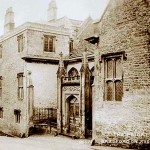 The Priory at the top of Market Street is a shadow after a local builder bought it in 1938 and asset-stripped it. It was a late medieval manor house with 18th century additions and belonged first to the Besills, then the Rogers family, for a long period to the Methuens, then the Tugwells and the Saunders, under whom it gained its fanciful name (it never was a monastery). Today, all that remains is the high wall with blocked 15th century windows and what was the 18th century kitchen wing.
The Priory at the top of Market Street is a shadow after a local builder bought it in 1938 and asset-stripped it. It was a late medieval manor house with 18th century additions and belonged first to the Besills, then the Rogers family, for a long period to the Methuens, then the Tugwells and the Saunders, under whom it gained its fanciful name (it never was a monastery). Today, all that remains is the high wall with blocked 15th century windows and what was the 18th century kitchen wing.


